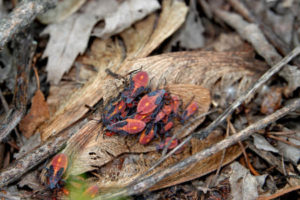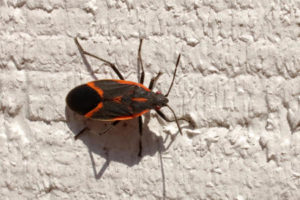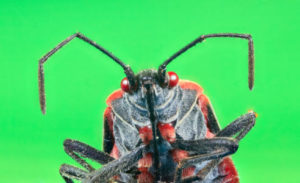Black and Red Bugs
By Zachary Ciras on August 23, 2022.
Occasional Invaders
It’s a great big world of critters all around us! The more one looks around, the more insects one will see. Some insects observed are small pollinators, some are garden insects who control pests which may be harmful to your plants, and some are true pests to your home and family. All have their place in the ecosystem. Some of these critters who are relatively harmless occasionally invade manmade structures. We rightly call these pests Occasional Invaders. quite often in Massachusetts and New Hampshire, occasional invaders are insects that are perfectly content to exist outside during the warm months of the year, but look to overwinter someplace better protected. What they find are gaps, cracks, holes, and other entry points around your home and other structures. These invaders may wander inside your home at any time of year, but as the weather starts to cool at night, we tend to see behavior closer to a migration than a meander.
Alarming Appearance

Boxelder Bugs on Maple Samara
One of these occasional invaders which frightens some home owners is the Boxelder Bug. The nymphs of Boisea trivittata are particularly odd looking. The immature bugs are largely red with black markings. They look like little red devil bugs with black open vests and red eyes. The congregation habits plus their oval unfinished appearance, presenting in a sudden, with bright red and orange hues, triggers the casual observer. By the time the second generation of bugs hatches, it is August and September. Boxelder bugs prefer very warm temperatures, and they can be seen congregating together in large clusters wherever the sun hits. This may result in the entire South or West side of your home being ostensibly covered in little black and red bugs. They will also grow together along fences, in leaf litter, and anywhere else they can catch some waves of heat from the sun. Boxelder bugs are somewhat elongated, flattened bugs measuring in at about 1/2″ as adults. The adults are black with red or orange markings, with 3 stripes on the area behind the head. Their Latin name, Boisea trivittata translates roughly to “three banded.” Nymphs are smaller and notably redder, and undergo 5 molts before becoming adults. Their red and orange marking likely serve as a defense to predation, in the same way colorful fish and birds signal danger to would-be predatory animals. When disturbed, Boxelder bugs can also emit a foul smelling odor as another means of defense.
A Nuisance, Not a Menace

A boxelder bug or Boisea trivittata
Boxelder bugs originally emanated from the West and Southwest of America. They currently have spread into all of America, into Canada and Mexico and Guatemala, and in 2020 became an invasive species in Chile. Boxelder bugs feed on boxelder trees as well as some Ash and Maple trees as well as various plants and fallen leaves. The feeding on the trees and plants is not largely to be considered of import related to the overall health of the forests. The damage they cause is usually minimal and does not permanently harm the flora. They can be found in deciduous and mixed forests, and are often overlooked around folks’ property. After overwintering, whether that was inside of a manmade structure such as your home, or under some leaf little or bark, or even in other clutter of different types, adults emerge from their sheltered spots. This is sometimes when homeowners first notice the bugs in and around their home. At that point in the season, they are attempting to leave the structure and reenter the outside world.
Boxelder trees are a fast growing, native maple variety which can thrive in just about any soil type and pollenates early in the springtime. Boxelder bugs emerge from they overwintering habitat and begin mating within a couple of weeks. Eggs will hatch when the temperatures are reliably above 70 degrees. The second generation hatching from eggs laid outside usually occurs in the late summer and early fall. Anywhere from 1 to 3 generations per year is typical for Boxelder bugs. The third generation, if it occurs, usually emerges around Halloween, which is a nice decoration for the season.
Boxelder bugs are true bugs, related to things like stink bugs, cicadas, and other tree and plant bugs. These bugs have piercing, sucking mouthparts intended for consuming the juices from trees and plants. They do not pose a threat to humans or animals. They are considered to be semi-social insects, grouping together in congregations where they mate, feed, and warm in the sun. They do not appear to have any real sort of structure to their aggregation like ants, wasps, bees, or other more organized insects do. They can fly miles to find locations to overwinter, and will fly onto host trees to mate and lay eggs. Despite their colorful markings, Boxelder bugs still serve as prey to other insects and animals such as grasshoppers, spiders, small rodents, and birds.
Trouble inside

A boxelder bug (Boisea trivittata)
The actual problems caused by Boxelder bugs besides their potential alarming appearance is minimal. Inside a structure in large numbers, their droppings may leave small dark stains. If in great numbers, they may produce an unpleasant odor. Unchecked, they can gather together on walls, curtains, and ceiling corners, as well as around windows and attics. They can prove unsightly and leave unpleasant remnants, but they are otherwise harmless. In many cases, a vacuum can be your best pest control tool, but be careful not to suck up too many, as the odor may linger inside of the machine.
Prevention is the best remedy
As with all occasional invaders, the proper steps to prevent the build up of a population near the house and then the proper exclusionary and preventative maintenance program at the structural level is the key to limiting a Boxelder bug infestation. If these black and red bugs are truly nothing you, considering removing Boxelder, silver maple, Ash, and other host trees from around your home and property. This is usually not required, however and good removal of fallen leaf litter is a better consideration to make to reduce the numbers. Cleaning up any sort of clutter, organic and inorganic debris, and stored items from around your property will limit the places where these bugs will congregate. Make sure your house is well sealed with caulking around seams, paint filling in cracks, and good window and door screens to prevent entry. A chemical barrier certainly goes a long way to prevent the issue as well. Twice per year treatments to the exterior of your home in key areas by a knowledgeable professional will help to deter the bugs from using your home to overwinter. A pest control professional will also offer a thorough inspection and give recommendations to help prevent occasional invader infestations.
Although these bugs are not a hazardous menace to your home, family, or foliage, not many people will willingly welcome them inside of our homes. They red, orange, and black coloring is concerning to a casual observer, but now that we can identify Boxelder bugs from any real threat. Boxelder bugs are just another one of the amazingly curious creatures in our back yards. To keep them out of your home, give us a call at 800-525-8084 and a professional pest control technician will address potential issues and offer a customized solution for your home and family.